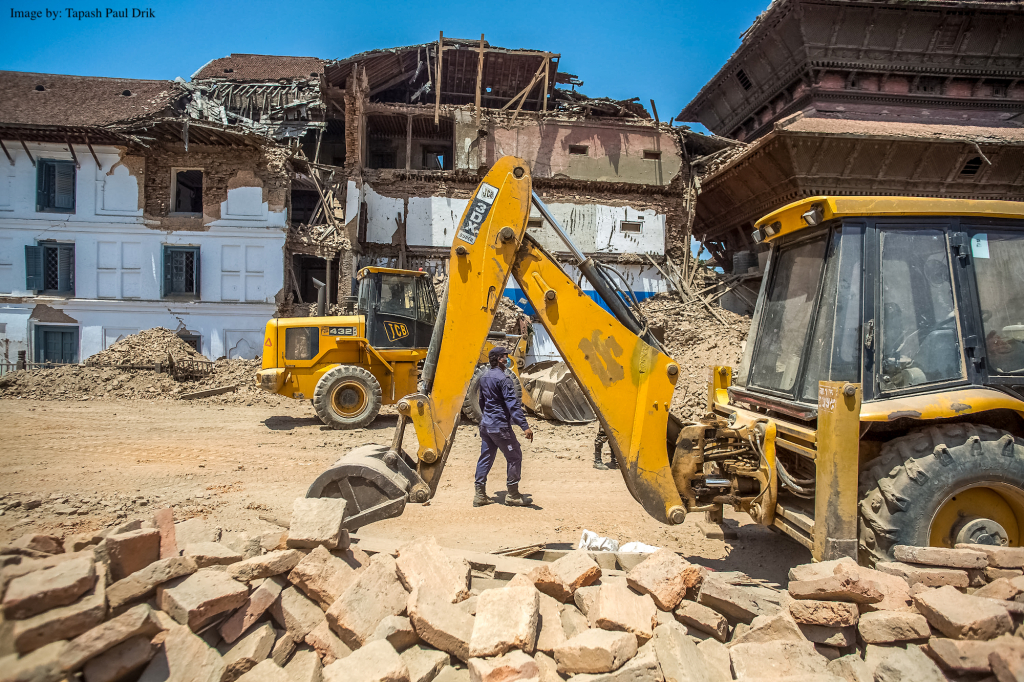After a 7.8 intensity earthquake struck Nepal (April 2015), urban search and rescue teams desperately searched for survivors buried amid the rubble of Kashtmandap – a historic building in the heart of the capital city, Kathmandu.
Once the search and rescue operations were over, the work of salvaging the historic timber fragments and wooden carvings of Kahstmandap was undertaken to restore the building, which continues to be a center for religious and cultural activities.

To facilitate the operation, ICCROM organized a training on First Aid to Cultural Heritage for the local police, army and volunteers to undertake the work of salvaging, documenting and storing the wooden fragments of the building. The training was organized in collaboration with the Department of Archaeology of Nepal, UNESCO, ICOMOS, ICOM and the Smithsonian Institution.
ICORP Türkiye members integral to the GEA Search and Rescue (SAR) Team were also in the field, where, following search and rescue activities, they contributed to the emergency stabilization of historic buildings and museums in Durbar Square – upon invitation from the Nepal Ministry of Cultural Heritage and Archaeology Museums.
This experience of stabilization of damaged historic buildings to rescue people and objects, together with salvaging historic building fragments after search and rescue and clearing of debris, underscored the need for greater cooperation and coordination between cultural first aiders and urban search and rescue teams, as significant heritage fragments can be inadvertently lost or swept away in debris clearance if there is no signage.
In 2018, UNESCO, INSARAG-International Search and Rescue Advisory Group, ICCROM and ICOMOS-ICORP Türkiye began a formal collaboration to enhance interagency cooperation and coordination for heritage safeguarding during urban search and rescue (USAR) and also as part of the ‘flexible response’ given by USAR teams upon request of the authorities of the host country.
Search and rescue teams are highly-trained military and NGO personnel with specialized skills and equipment to assist during major disasters. Given the significant resources and costs associated with establishing and maintaining certified USAR teams and their deployments, discussions on maximizing professional life-saving resources of USAR teams in various capacities are ongoing. For conducting global consultations, INSARAG has set up a Flexible Response Working Group (FRWG).
As part of FRWG, INSARAG constituted an expert sub-group on cultural heritage, inviting global consultations and a review of guidance for Undertaking Search and Rescue at Heritage Sites, prepared by UNESCO, ICCROM and ICOMOS-ICORP Türkiye in collaboration with GEA Search and Rescue Group.
Co-authored by Aparna Tandon, Senior Programme Leader, FAR Programme, ICCROM; Dr Zeynep Gül Ünal, ICOMOS-ICORP Türkiye; and Cem Behar, GEA USAR Team, the guidance note was unanimously accepted as part of non-binding technical guidance for USAR teams.
Specific content contributions were generously made by members of ICOMOS-ICORP Türkiye and GEA Urban Search and Rescue Team – including Umut Dinçşahin, Nevra Ertürk, Kadir Erkan, Mehmet Ünal, Zeynep Ece Atabay and Alessandra Macedonio – and Mohona Chakraburtty, ICCROM FAR Programme Assistant.
The guidance note was approved after global consultations held by FRWG, which were facilitated by Chair and Co-Chair Paolo Vaccari (Italy) and Paul Baxter (Australia). FRWG constituted a sub-working group on cultural heritage with Chair and Co-Chair Jing Wang (China) and Aparna Tandon (UNESCO-ICCROM). The sub-working group members who reviewed the guidance include Ciro Bolognese (Italy), Gary Foo (UK), Dr Zeynep Gul Unal (ICOMOS-ICORP Türkiye), Ahmet TURUNÇ (Türkiye), Ahmad Abdullah Al Kuwari (Qatar), John Dumsick (USA) and John Cawcutt (Australia).
A huge step forward toward the integration of cultural heritage with humanitarian assistance
Underscoring the importance of safeguarding heritage during emergencies, Sebastian Rhodes Stampa, Secretary of INSARAG, has said that the guidance is an important step forward in developing practical strategies for protecting heritage. In a statement given to ICCROM, he stressed the ongoing need for interagency cooperation:
“The new INSARAG USAR & Cultural Heritage – Guidance Note is a highly valuable resource for USAR teams. It specifically addresses the unique challenges and considerations associated with cultural heritage preservation in urban search and rescue operations. By incorporating the expertise of our partners, ICCROM and UNESCO, organisations renowned for their commitment to safeguarding and preserving cultural heritage, the guidance note equips USAR teams with comprehensive knowledge and practical strategies to effectively manage situations where cultural heritage assets are at risk. This partnership underscores the crucial importance of interdisciplinary cooperation between disaster response and cultural heritage protection. This collaboration ultimately enhances the capabilities of USAR teams in preserving cultural heritage during emergency operations, fostering a holistic approach to disaster response that prioritises both lives and the preservation of our shared cultural legacy.”
ICCROM, through its flagship capacity development programme, First Aid and Resilience for Cultural Heritage in Times of Crisis, has consistently worked with disaster reduction civil protection and humanitarian aid agencies to foster greater coordination for building disaster resilience and safeguarding at-risk heritage.
